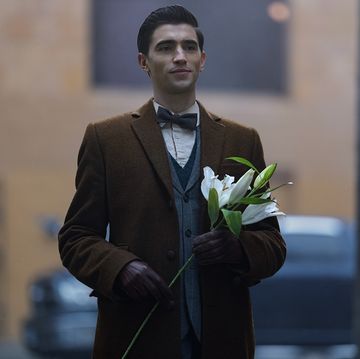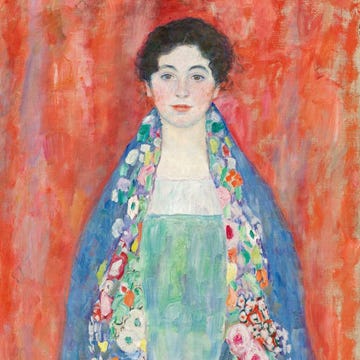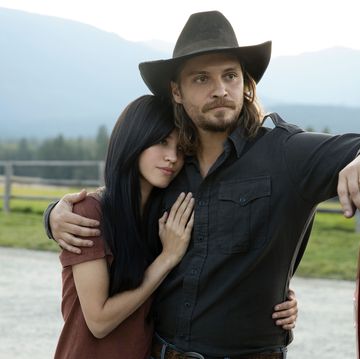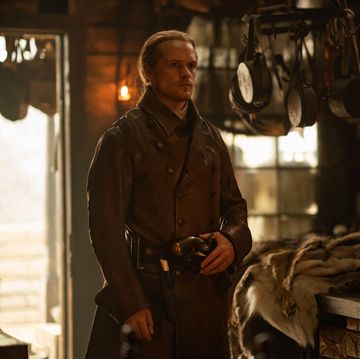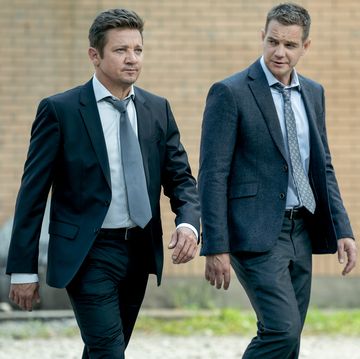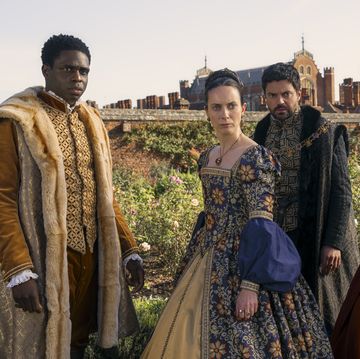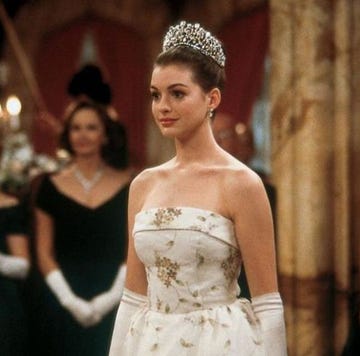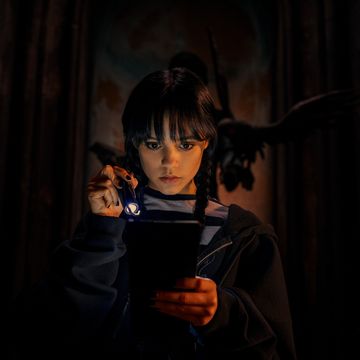No matter what you've heard about its art and architecture, the town of Marfa, Texas, still looks like classic ranch country. Apart from a cluster of cafés, hotels and homes, this land belongs to the animals. Cattle and other livestock easily outnumber the human population, which hovers around 2,420. The sky is big and astringent, filled with the kind of white light that makes you squint. The ground is patchy, a quilt of prairie grass, tumbleweed and dirt.
Driving east of Marfa's main drag, you might spot what looks like an abandoned ranch, just one rainfall away from desert. But the locals see something else: the makings of a drive-in movie theater soon to screen avant-garde as well as mainstream films — open-air Andy Warhol or John Huston, for instance — for the community's swelling number of art connoisseurs. Harvard architecture professor Michael Meredith has begun drawing up plans for the site, and Josh Siegel, a film curator at the Museum of Modern Art in New York, is programming the first season, to feature, among other things, silent films with live musical accompaniment.
The drive-in is not expected to be up and running until next year, but everyone in town knows about it. And everyone in town talks about it. Part of the buzz is surely due to the fact that the nearest movie theater is a good thirty-minute drive away. But it may also have something to do with the notion that an art-house drive-in is pure Marfa: an experimental art project shot through with nostalgia for small-town Americana.
The drive-in is the latest venture of Fairfax Dorn and Virginia Lebermann, two women whom many see as the new face of Marfa — young, smart, fashionable, professional and thoroughly urban, at least when they're not being down-to-their-roots rural. Owners of the Ballroom, a local art space that doubles as a music hall, they are adding to the mix of culture and nature that makes this colony in the heart of West Texas, about three hours from El Paso, so appealing.
Founded in 1883, Marfa originally served as a water stop for the Texas and New Orleans Railroad. As the story goes, the wife of a railroad executive named the place after Marfa Ignatyevna, a minor character in Dostoyevsky's Brothers Karamazov.
A freight train still rumbles through the center of town, which extends just a few blocks, but these days so does a mix of Chevy pickup trucks, Jeeps and U.S. Border Patrol vehicles. And then there are the private jets and rented sports cars that carry the art-world cognoscenti and occasional celebrities (Julia Roberts has been spotted, among others). Judd created the Chinati Foundation to oversee a permanent collection of his own work and that of others. The Chinati office today (from left): David Tompkins, director Marianne Stockebrand, Rob Weiner, Nick Terry. The furniture is by Judd; the wall piece, Nowheresville (2003), is by Jack Pierson.
Most people come to see the legacy of the late artist Donald Judd, who in the 1970s chose to make Marfa his home and the site of a vast indoor-outdoor museum for his Minimalist sculpture, which could literally be described as edgy. But recently the community has begun to grow beyond its art-world roots. Nobody knows this better than Tim Crowley and Lynn Goode Crowley, of Houston, who discovered Marfa more than a decade ago, built a home here and have since become the ultimate local hosts. They've opened the Goode Crowley Theater and the Marfa Book Company, one of the town's popular hangouts. And they've introduced many friends from Houston, where Tim still works as a trial attorney, to the pleasures of life in Marfa.
These are not, for the most part, material pleasures. Although the Crowleys live in a breathtaking home designed by Houston architect Carlos Jiménez — a distinctly modern ranch house that wraps around a dazzling terraced pool — they have in some respects been roughing it. Marfa still has virtually no shopping for either luxuries or essentials. And the handful of restaurants keep frustratingly irregular hours. Residents drive half an hour away to nearby Alpine (population 6,000) for groceries and more.
But there is some activity on the horizon. An organic market opened last spring; a new restaurant debuts this month. And as if to compensate for Marfa's material shortcomings, there are plenty of cultural events that bring the community together. Even if you can't fill your prescription here, you can buy art from a growing number of galleries, attend plays or book readings and catch concerts and multimedia events. You can also take flying lessons and get a bird's-eye view of the expansive — many say restorative — landscape.
And there is so much goodwill in Marfa. (When you're not always running errands, there is more time to get to know your neighbors.) A typical night, Tim Crowley says, consists of dropping by someone's house for dinner or maybe bumping into an old acquaintance who's passing through — like Tim's friend Robert Irwin, the San Diego–based artist. "This is still such a small town that one new couple moving in can improve your quality of life," Tim explains. "This might be the couple that opens the farmer's market or the one that does baked goods. New people are always welcome here — it's a very tolerant place."
Marfa's last cultural flowering was in the 1930s and '40s, when the Ballroom space was actually a ballroom and the presence of the Fort D.A. Russell military base dominated the town. The base grew especially busy during World War II and brought a lot of activity to Marfa in the form of businesses, movie theaters and such. Most of these closed after the fort did, in 1946, leaving the area rather sleepy. That's how it seemed when James Dean, Elizabeth Taylor and Rock Hudson rode into Marfa in the 1950s to film the movie Giant, giving the place a bit of rough-hewn glamour.
And that's how it seemed decades later in 1978, when Judd bought 340 acres of what used to be Fort Russell to house his own large-scale sculptures and works by his comrades, such as Dan Flavin and John Chamberlain, in what he then called the Art Museum of the Pecos. He eventually changed its name to the Chinati Foundation, but the concept of museum-quality work that didn't fit so neatly into a museum remained. In the late 1980s, Judd began an official residency program for artists. And with his death, in 1994, his estate also got into the act. Thanks to the Judd Foundation, a dozen of his other personal living, working and exhibition spaces, all right downtown, have been preserved, as though the artist had just stepped out for coffee and were about to return.
Although the Ballroom's founders are both from prominent Texas families, they did not meet until they were living in New York in the 1990s. Virginia Lebermann was working on an M.F.A. in creative writing at New York University, while Fairfax Dorn was working in development at the Whitney Museum. Introduced through mutual friends, they stayed in touch when they left New York for greener pastures. "We kept talking about opening some kind of multimedia art space in the desert," Dorn says.
Lebermann spotted the building that is now the Ballroom, a 1927 dance hall turned auto-repair shop, on a drive through Marfa in 2002 and knew she'd found their venue. Since their grand opening the following fall, they've put the space to use for frequent concerts and twice-yearly art exhibitions, bringing a combination of musicians (Yo La Tengo, Jeff Tweedy and Mingo Saldivar) and artists (Christian Jankowski, Polly Apfelbaum and Jonathan Meese, to name a few). Trailing these acts are twentysomethings who come from as far away as Austin to be part of the scene. Many stay at the vintage Thunderbird Hotel, which Lebermann also owns and which may be Marfa's answer to André Balazs's Standard hotel in West Hollywood.
Lebermann has recently finished expanding the 1959 building to include a new concert hall and bar with patio, just in time for Open House on October 6 and 7. That's the annual weekend event during which Marfa's population basically doubles as all of the local art spots hold parties and openings. The Chinati Foundation, which launched the Open House concept when Judd was still alive, ropes off a stretch of Highland Avenue to make room for a street party featuring Mexican food and mariachi bands.
While Open House is by far Marfa's biggest attraction, a growing mix of visitors — from the art committed to the culturally curious — are making pilgrimages throughout the year, as well. Lebermann says the ongoing influx of intriguing people is one of the things that make the community tick.
"I always compare it to the Hamptons of the '50s," she says. "Marfa is so rural and so remote, but you get to live in this tiny Texas town that has such an interesting flow of people coming through—like curators from London, Paris, New York and L.A." Living in Marfa, then, means being a perpetual host. It's a place defined by looking outward and opening its doors to others. In Dorn's case, it often means putting up artists overnight in her house or in the open-air sleeping quarters in her backyard.
Naturally, a few of these visitors to West Texas decide they want to stay. One is Jeff Elrod, who recently had work in group shows at Angstrom Gallery in Los Angeles and Gagosian Gallery in New York. He first came to town during a Chinati Foundation residency in 1998. "One can make as many connections in Marfa as in New York," he says. "I came out here and found my first dealers — Pat Hearn from New York, Paolo Curti from Milan — who were passing through." Last year he returned to live here full-time.
If the popularity of Open House is one gauge of Marfa's growth, another is the escalating cost of real estate, which inspires comparisons to the early days of Aspen and Telluride. Whereas just ten years ago it was possible to buy an adobe house for $30,000, the same property today might sell for $300,000. For Sale signs by Marfa Realty, with its dramatic longhorn logo, litter the town.
"There is some goofball speculation — people reading a magazine article and calling up to buy something over the phone," says Elrod. "But there are also a lot of people coming here looking for second or third homes, from Houston, Dallas, Santa Fe." Though the part-time population has edged upward in the past five years, the full-time population hasn't changed much, a measure of Marfa's stability.
And yet economic growth is bound to create some tensions, and a few journalists have cast the town as one torn between two cultures: rich versus poor, white versus brown, artists versus ranchers. An exposé published in Salon, titled "Showdown in Marfa," pointedly referred to Chinati as ChiNazi.
Tim Crowley feels this is all overblown. "It's a complete red herring. Is Chinati the butt of funny jokes among ranchers? Sure, no question. But I think they also point to it with some pride — even if they do not understand why people would fly here in private jets to see a bunch of fluorescent lights," he says, referring to work by Dan Flavin.
He also thinks that too much is being made of the frenetic Marfa real-estate scene. "The market is stabilizing," he contends. "And it's still cheaper to buy an existing home here than to build one from scratch." When asked about the changes that he sees under way, Crowley does not gravitate toward property values but, like so many of his neighbors, toward the growing number of places to eat.
One local favorite is Maiya's, an Italian hot spot. Maiya Keck came to work for the Judd estate after art school, and five years ago she opened a trattoria so sleek that a reporter for the New York Times said it "could have been airlifted from South Beach." Keck recently opened Marfa's first organic grocery, with artisanal cheeses and organic produce.
Debuting later this month is a restaurant from Tom Rapp and Toshi Sakihara, who are partners in états-Unis, on New York's Upper East Side. états-Unis-Marfa will seat fifty, feature an extensive wine list and serve small plates of the sort that Rapp and Sakihara do at their place in New York. In a destination as diminutive as Marfa, this feels like progress. So does the drive-in movie theater.
"The town is not just about Judd anymore," observes Robert Halpern, editor and publisher of the Big Bend Sentinel, the local newspaper. "There are so many different things going on: we have theater, music, literature, art.
"They say this is the new Santa Fe, but they're wrong. This is the new Marfa."
A visit to Marfa, in the heart of West Texas, is best made in fall or spring. But don't let the calendar stop you from visiting in any season—each has its pleasures.
(The area code for all telephone numbers is 432.)
Getting There
Fly into El Paso or Midland airport and rent a car. It's about a three-hour drive from either city.
Where to Stay
Hotel Paisano
Built in 1930 and declared a National Historic Landmark in 1978, the forty-one-room hotel has old-world charm in the form of wrought-iron balconies, French doors and penny-round tile work in the bathrooms. For better and worse, it does not feel much changed since 1955, when the cast of
Giant
stayed here.
Rooms $99 to $210. 207 North Highland; 729-3669;
hotelpaisano.com.
Thunderbird Hotel
If the Paisano attracts fans of James Dean, this nouveau roadside motel attracts followers of Donald Judd. The twenty-four rooms are simply but thoughtfully put together, with mod blond-wood furniture and with Peruvian blankets warming the beds. Be sure to bring earplugs to muffle the noise of the train that runs through nearby at night.
Rooms $125 to $200. 601 West San Antonio; 729-1984;
thunderbirdmarfa.com.
Where to Eat
Maiya's
Maiya Keck offers a seasonal menu for her Italian restaurant, which has more vegetarian options than anywhere else in town.
−
103 North Highland; 729-4410;
maiyasrestaurant.com.
The Get Go
Keck's new gourmet grocery features high-quality meats, cheeses and organic produce.
208 South Dean Street; 729-3355.
The Brown Recluse
Open most (but not all) mornings until 1:00 P.M. Order the
migas—eggs fried with tortilla,
queso fresco,
onion, tomato and jalapeño.
111 West San Antonio; 729-1811.
États-Unis-Marfa
This restaurant promises a good aged, charcoal-grilled steak, fish overnighted from Hawaii and a large garden for outdoor dining.
107 West San Antonio; 729-3264.
The Pizza Foundation
This restaurant draws a good lunch crowd and serves the best slice around. Cool off with a limeade in the flavor of your choice—such as plain, strawberry or pineapple.
101 East San Antonio; 729-3377.
Where to See Art
The Chinati Foundation
The original reason behind all the pilgrimages to Marfa, this 340-acre campus may be the largest monument to Minimalism in the world. It consists of permanent installations of Donald Judd's most ambitious works, along with pieces by his artist friends. Each year brings a temporary exhibition as well, and this month during Open House (October 6 and 7), Chinati unveils a series of early galvanized-steel sculptures by David Rabinowitch and plans for an unrealized, site-specific project that he dreamed up with Judd called the Pinto Canyon Group. Call ahead for a space on the guided tours, which take place Wednesday through Sunday, and set aside a full day to spend there.
1 Cavalry Row; 729-4362;
chinati.org.
Judd Foundation
The organization oversees a dozen living, working and exhibition spaces downtown that the artist created during his lifetime. Though the spaces are usually open only by appointment or for tours, three are staffed to welcome the public during Open House: the Cobb House and the Whyte Building, packed with Judd's early paintings and sculptures, and the Block, the compound where he and his family lived. The Block is by far the most personal of the spaces, a 3-D biography of the artist. It contains his 10,000-volume library (heavy on art, science and the classics), a collection of Navajo weavings and arrowheads, and a vast array of cooking utensils. Also look for teenaged touches in Flavin Judd's bedroom. (Yes, Judd named his son after artist Dan Flavin—a moment of great affection before the friends' falling out.)
104 South Highland; 729-4406;
juddfoundation.org.
Ballroom Marfa
Host to lively concerts and movie screenings, the Ballroom also brings the international contemporary- art scene into its cavernous space. Case in point: the fall exhibition (through February 3), "Every Revolution Is a Roll of the Dice," curated by the respected Bob Nickas, includes such international art stars as Huma Bhabha (Pakistan), Carol Bove (Switzerland) and Wangechi Mutu (Kenya).
108 East San Antonio; 729-3600;
ballroommarfa.org.
Eugene Binder
The first gallerist in town, Binder is also the most serious. In addition to this space, he owns an appointment-only gallery in New York's Long Island City, not far from P.S. 1, and his Texas program features some of the same artists he has shown in New York—from painter John Pomara to the more conceptually driven Nicholas Knight.
218 North Highland; 729-3900.
EXHIBITIONS 2D
Owner Dennis Dickinson was once a set designer in Los Angeles, and his Marfa gallery shows off his knack for creating a thoroughly imagined world where every piece is hung just so, across a handful of small rooms. His specialty is contemporary abstraction. 400 South Highland; 729-1910;



